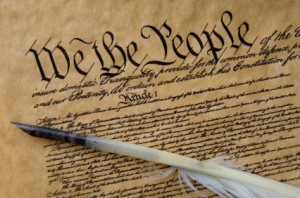A Whirlwind Tour of the Supreme Court’s Commerce Clause Jurisprudence
 There is a widely held view that Congress has virtually unlimited power to legislate, especially concerning economic matters. Consider, for example, the passage of the controversial Patient Protection and Affordable Care Act two years ago. While Congress’ power to regulate the economy is not completely unbounded, it is very far-reaching indeed. However, it was not always so.
There is a widely held view that Congress has virtually unlimited power to legislate, especially concerning economic matters. Consider, for example, the passage of the controversial Patient Protection and Affordable Care Act two years ago. While Congress’ power to regulate the economy is not completely unbounded, it is very far-reaching indeed. However, it was not always so.
Under the Articles of Confederation, Congress was powerless to address conflicting commercial regulations imposed by the several states. To remedy that flaw, the enumerated powers given to Congress under the Constitution included the authority “[t]o regulate Commerce … among the several States.”
At the time the Constitution was ratified, “commerce” referred to trade—buying and selling products—but it did not include all economic activity, such as manufacturing, agriculture, and labor. In the ratification debates, there was little deliberation over the Commerce power because it was understood to be an insignificant threat to local or non-commercial affairs. James Madison emphasized that point in Federalist No. 45.
Early Congresses rarely invoked the Commerce power. The Supreme Court’s first opportunity to determine its scope did not arise until Gibbons v. Ogden (1824). In that case, the Court held that Congress may regulate interstate commerce, but not commerce that doesn’t extend to or affect other states.
Over the next century, the Court reiterated that Congress’ Commerce power did not include regulation of production in anticipation of trade. In these decisions, the Court emphasized the distinction between commerce and other types of economic activity that are not commerce: “Without agriculture, manufacturing, mining, etc., commerce could not exist, but this fact does not suffice to subject them to the control of Congress” (Newberry v. United States, 1921).
A slight shift occurred in 1914, when the Court held that where interstate and intrastate aspects of commerce are so intermingled, the Constitution permits regulation of interstate commerce even if that results in incidental regulation of purely intrastate commerce. But in general, the Court’s view of Congress’ Commerce power remained unchanged. In 1935, the Court held that Congress may not regulate intrastate sales of poultry, and as late as 1936, the Court invalidated a federal law regulating labor because “the relation of employer and employee is a local relation.”
The Court’s century-old Commerce Clause jurisprudence ultimately bowed to far-reaching New Deal laws. In NLRB v. Jones & Laughlin Steel Corp. (1937), the Court upheld the National Labor Relations Act against a Commerce Clause challenge, holding that Congress may regulate intrastate production if it has a “close and substantial relation to interstate commerce.” And in United States v. Darby (1941), the Court declared that “[t]he power of Congress over interstate commerce is not confined to the regulation of commerce among the states.”
Wickard v. Filburn (1942) is generally considered the most expansive Commerce Clause decision to date. In that case, the Court held that Congress could regulate a farmer’s production and consumption of homegrown wheat because even though his activity was local, was not commerce, and did not substantially or directly affect interstate commerce, it could, in combination with others’ similar conduct, affect interstate commerce.
In 1964 and 1971, the Supreme Court rejected Commerce Clause challenges to the application of civil rights laws to motels and restaurants, and to a federal criminal law prohibiting local instances of loan sharking. In these cases, the Court dismissed arguments that: the regulated activity was not commercial, Congress was legislating against moral wrongs, the activity was purely local, and the economic effect of the regulated activity was so small as to be trivial.
In United States v. Lopez (1995) and United States v. Morrison (2000), the Supreme Court resisted further expansion, a reminder that even after the New Deal cases, Congress’ Commerce power still has outer limits. Because the federal laws in Lopez and Morrison (prohibiting possession of a gun near a school and gender-motivated violence, respectively) regulated local activity having no effect on interstate commerce, they were really exercises of the general police power that belongs exclusively to the states.
In the case now pending before the Supreme Court on the Patient Protection and Affordable Care Act, the issue is whether Congress has the power to compel non-participants into the health insurance market, so that they can then be regulated. It’s a novel question, and no precedent governs the Court’s decision. During its oral argument, the federal government asserted that every person is an “actuarial reality” whose current existence and eventual mortality creates a statistically measurable insurance risk.
By that theory, everyone is inescapably a “participant” in the health insurance market and therefore subject to federal regulation. Such metaphysical abstraction threatens not merely to further stretch, but finally to break the Framers’ structural design that for 225 years has preserved individual liberty and served as a check on unlimited federal power.

